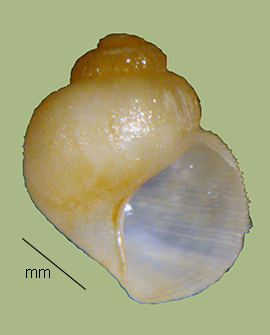> Habitat & Distribution
Antroselates spiralis was described from streams running through caves and sinks in Kentucky and southern Indiana. To quote Hubendick (1963) directly, "always found on the undersides of large stones in running water. I never found one under a small stone. I can easily understand why an unpigmented snail should stay on the undersides of stones in the springs, but not why it should retain this habit in the total darkness of caves."
A broad-brush review of the zoogeography of North American cavesnails has been offered by Hershler & Holsinger (1990). FWGNA incidence unranked.
> Ecology & Life History
A broad-brush review of the zoogeography of North American cavesnails has been offered by Hershler & Holsinger (1990). Subterranean karst waters such as prevail in Kentucky and Indiana are, of course, very rich in calcium and many other minerals, as well as constant in their temperature. Such ecosystems are typically based on fine organic matter raining down from the lighted world above. Cavesnail populations typically demonstrate stable population densities year round, as though reproduction might be continuous.
> Taxonomy & Systematics
Hubricht (1963) described the animal as translucent whitish and blind, with a simple penis, lacking lobes, papillae, accessory ducts or glands. Some confusion about the radular morphology led Taylor and Burch to transfer Antroselates to the Micromelaniidae, but Hershler and Hubricht (1988) returned the genus to the Hydrobiidae, suggesting cochliopine affiliations. Hershler & Thompson (1992) included Antroselates in their review of the hydrobiid subfamily Cochliopinae. The CO1 gene tree analysis of Liu et al (2001) yielded the surprising result that Antroselates was more genetically similar to Amnicola than to typical cochiopines, however. Wilke et al. (2013) transferred Antroselates to the Amnicolidae, despite the absence of the second penial lobe otherwise diagnostic for the family.
> Essays
- Earlier versions of this website, online until August of 2016, adopted the large, broadly-inclusive concept of the Hydrobiidae (sl) following Kabat & Hershler (1993). More recently the FWGNA project has shifted to the Wilke et al. (2013) classification system, distinguishing a much smaller Hydrobiidae (ss) and elevating many hydrobioid taxa previously ranked as subfamilies to the full family level. For more details, see The Classification of the Hydrobioids.
> References
Hershler, R. H. & J. R. Holsinger (1990) Zoogeography of North American hydrobiid cavesnails. Stygologia 5: 5-16.
Hershler, R. & L. Hubricht (1988) Notes on Antroselates Hubricht, 1963 and Antrobia Hubricht, 1971 (Gastropoda: Hydrobiidae). Proc Biol. Soc. Wash. 101: 730-740.
Hershler, R. & F.G. Thompson (1992) A review of the aquatic gastropod subfamily Cochliopinae (Prosobranchia: Hydrobiidae). Malacological Review Supplement 5: 1 - 140.
Hubricht, L. (1963) New species of Hydrobiidae. Nautilus 76: 138 - 140.
Kabat, A.R., and R. Hershler (1993) The prosobranch snail family Hydrobiidae (Gastropoda: Rissooidea): review of classification and supraspecific taxa. Smithsonian Contributions to Zoology 547:1-94.
Liu, H-P., R. Hershler & F.G. Thompson (2001) Phylogenetic relationships of the Cochliopinae (Rissooidea: Hydrobiidae): An enigmatic group of aquatic gastropods. Molec. Phyl. Evol. 21: 17 - 25.
Wilke T., Haase M., Hershler R., Liu H-P., Misof B., Ponder W. (2013) Pushing short DNA fragments to the limit: Phylogenetic relationships of hydrobioid gastropods (Caenogastropoda: Rissooidea). Molec. Phyl. Evol. 66: 715 736.








